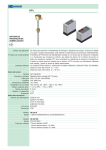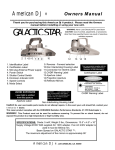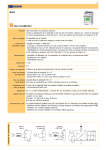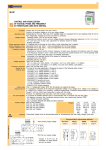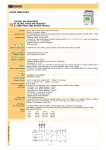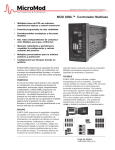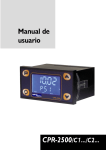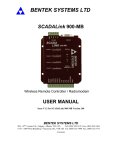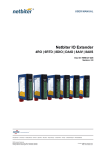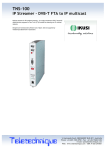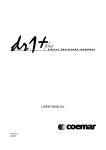Download CPR2500 Manual2
Transcript
User’s manual F Segle XX, 91 E08032 - Barcelona ( T: +34 934 560 995 F: +34 934 354 532 ü www.disibeint.com [email protected] Programmable panel meter IPD Assembly Wall assembly: Window of 46 x 91+0,5 mm (2.5" x 3.5" +0,2 -0 -0 ) Made with ABS (UL94-HB) General cares in the installation The equipments must not be placed in environments too near to power elements such us circuit breakers, triacs, rectifier bridges, high voltage transformers, etc. As far as possible, the equipments will be isolated from the emitters of electrical disturbances by means of, for instance, a shield connected to ground. NO YES The equipments will not be exposed to extreme temperatures and humidities: · Maximum room temperature for optimal operation: 40ºC · Maximum room humidity without precipitation: 90%. NO YES The connections must be done separating, phisically, the measurement signals from the control or power signals. Do not use the same connection for the power supply of the equipment and for the control line of the circuit breakers, motors, etc. NO YES In a general way, it is recommended to use an exclusive supply line for the equipments connected directly from the main and provided with the appropiate protections. If this is not possible, install an isolation transformer with the shield connected to ground. 2 Cautions with the connection Before applying the supply voltage or the signals, be sure that the wiring is correct. In the current analog inputs, check that the polarity is the right one and the shunt is present. If it is internal, by means of the proper jumper and if it is external, checking that the shunt resistance (3,74 ohm) is connected to the right terminals. In the Pt 100 inputs, checking the third wire will avoid saturated indications. In the inputs for mV and termopar, beside to the polarity is important to assure that the internal shunt of that channel is not selected. Every voltage between terminals higher than 3 V, from the same channel or between different channels, may cause damages in the equipment. It is always recommended to use twisted wire cable with shield for the signal lines and to use different pipelines than the ones for power or control. For a right shielding, connect it to a good quality ground (instrumentation ground) in only one of the sides. Do never connect to ground both sides of the shield. Avoid, as far as possible, the electrical ground where the circuit breakers, motors and power units are connected to. Usually, due to the deficient quality of these type of grounds, they are a source of electrical disturbances. It is recommended to use 1 mm2 cooper cable for the signals to be measured. The connection of the communications must be exclusively done with twisted and shielded cable. Inputs connection Internal jumper S1 in position 2-3 (page. 7) Internal jumper S1 en posición 1-2 (page 7) 3 Descripcion of the front screen Measure Status of the digital inputs TAG Status of the digital outputs Keyboard Error messages At any place, returns to the preceeding menu. Check probe and connections Measure is over the high limit or 9999 Advance to the next step. Data validation. Measure is over then low limit or -1999 Increases value Decreases value Main menu Starting screen Alarm 1 setting Change value Alarm 2 setting Change value Alarm 3 setting Change value Menú configuración Desde cualquier pantalla del menú regresa a la pantalla de inicio Pantalla inicial Hasta que cambie el menú Configuración Entrada Analógica 4 Configuración Alarmas Configuración Configuración Salida Analógica Comunicaciones (opcional) Configuration of the analog input Defines type of input Type Termopar -Type B -Type R -Type S -Type N Indication physical units Noise filter -Type E -Type K -Type S -Type T Peaks filter 0-15 Minimum limit -No decimal -1 decimal -2 decimals -3 decimals Change value Maximum limit Average filter 0-9 Text editor of lower line of main screen Change value Change value Advance letter Change value No linealization Number of decimals Reading correction Linealización Change value Linealization editor Linealization editor PXX - Indication of the linealization point being edited Repeat this process for all the required linealization points. Select the linealization point from 1 to 20. When point 0 is selected, the linealization editor is exited. Measure reading before to linealizate in the edited point. Measure reading after to linealizate in the edited point. Configuration of the alarms (AL1, Al 2, AL3) Function output Relay contact - Non active alarm - Maximum alarm - Normally opened Hysteresis of the alarm Change value - Normally closed - Maximum alarm - Window alarm - Regulation T/N low reverse (heat) - Regulation T/N high direct (cold) - Regulation T/N symmetric reverse (heat) - Regulation T/N symmetric direct (cold) 5 Configuration of the communications Communication speed Modbus address - 38400 bps - 19200 bps - 9600 bps Modbus speed No communication Communication test - High speed - No Rx and Tx - Receive messages not for him - Standard - Low speed Addresses of the communications - Answer - Receive message with CRC error - Receive message with wrong command Configuration of the analog output (optional) Type of output - No output - 0-20 mA Output minimum limit Change value Output maximum limit Change value Output measured in error Change value When the measure shows Err, this value is generated - 4-20 mA Communications The communications channel operates with RS485 wiring. Protocol is ModBus RTU. Example of connection Connection of a network of devices to a PC using RS485. Conversion options PC Connector Sub-D 9 pins Female 6 Modification of internal jumpers The housing must be opened in the case that the jumpers’ default setting wants to be changed. By pressing the two nails at each side of the housing, the cover can be removed. EVERY TIME THAT THE HOUSING MUST BE OPENED, BE SURE THAT THE EQUIPMENT BE WITHOUT VOLTAGE IN ALL THE TERMINALS. Each analog input has a two positions jumper that allows to choose between the general input and the input of mA with internal shunt. Once the jumper is set in the desired position, use the configuration program to select the input type. Jumper in 2-3* Pt 100, PTC, mV, V, TP, 0-4...20 mA (without internal shunt) Jumper in 1-2 0-4...20 mA (with internal shunt) * Default position is 2-3 7 Technical characteristics - Number of inputs: ....................... 1 input - Types: ............ PTC, TP, RTD, mV, V, mA - Impedance: ....................... >1 MΩ (mV) & ..... internal shunt 3,75 Ω 1% 25 ppm (mA) - Range CJC: .... 0 a 50 °C (internal sensor) - Standards for signals: ........... IEC584 (TP) .................................... and IEC751 (Pt 100) - Termopar ............... J, K, R, S, T, E, N, B - Pt 100 ..................................... -200/600 °C - PTC .......................................... -50/150 °C - Voltage: ....................... ±75 mV & ± 2 VDC - Current: .................................... 0..4-20 mA - Linealizatión: ............................... 20 steps - Precision at 25 °C: ......................... ± 0,1% - Sampling time: .................. 125 ms (1 ch.) .............................................. 250 ms (2 ch.) Logical inputs (option): - Logical inputs ............... 3 x 220 VAC/DC ................................ (24 VAC/DC in option) - Current consumption: ............. 2 mA máx. Analog outputs (option): - Quantity: ............ 1 or 2, common ground - Type: .............. mA (V with external shunt) - Resolution: ...................................... 13 bits - Output ranges: ........................ 0..4-20 mA - Precision at 25 °C: ........................ ± 0,2 % - Refresh time: ................................. 250 ms - Isolation: .......................................... 500 V - Maximum load: .............................. 500 Ω Digitals outputs: - Relays SPST NA .......... 3 x a 250 VAC/1A - Isolation ............................................ 500 V Output auxiliary voltage: - Output 1: ................. 18 VDC no stabilised - Maximum output current: ............... 50 mA - Isolation ............................................ 500 V - Output 2 (opt.): .... 5 VDC stabilised (opt.) - Maximum output current: ............... 20 mA - Isolation ............................................ 500 V ........................ (except with analog output) Communications: - Type: ............................................. RS-485 - Protocol: ............................... Modbus RTU - Speed: ........... 9600, 19200, 38400 bauds Operation limits: - Ambient temperature: .............. 0 a 50 °C - Storage temperature: ............ -20 a 70 °C - Relative humidity: .............. máx. 85 HR% ................................ (without condensation) Directive CE: - Emmision/Inmunity: EN 50081/EN 61000 Supply and consumption: - Voltage: ..... 60..250 VAC & 22..250 VDC .................................... 20..60 VAC (option) - Frequency: ................................. 50..60 Hz - Consumption: .................................... 2 VA CONCEPT MEASURE (AI1) ALARM SET 1 (AL 1) HYSTERESIS ALARM 1 (AL 1) ALARM SET 2 (AL 2) HYSTERESIS ALARM 2 (AL 2) ALARM SET 3 (AL 3) HYSTERESIS ALARM 3 (AL 3) READ STATUS ALARM 1 (AL 1) READ STATUS ALARM 2 (AL 2) READ STATUS ALARM 3 (AL 3) READ STATUS OUTPUT 1 (DO 1) READ STATUS OUTPUT 2 (DO 2) READ STATUS OUTPUT 3 (DO 3) WRITE STATUS OUTPUT 1 (DO 1) remote mode WRITE STATUS OUTPUT 2 (DO 2) remote mode WRITE STATUS OUTPUT 3 (DO 2) remote mode STATUS DIGITAL INPUT 1 (DI 1) STATUS DIGITAL INPUT 2 (DI 2) STATUS DIGITAL INPUT 3 (DI 3) DATATYPE Word with sign Word with sign Word with sign Word with sign Word with sign Word with sign Word with sign Bit Bit Bit Bit Bit Bit Bit Bit Bit Bit Bit Bit MODBUS REGISTER 30011 40035 40036 40038 40039 40041 40042 30001 BIT 9 (30001.9) 30001 BIT 10 (30001.10) 30001 BIT 11 (30001.11) 30002 BIT 2 (30002.2) 30002 BIT 3 (30002.3) 30002 BIT 4 (30002.4) 40095 BIT 0 (40095.0) 40095 BIT 1 (40095.1) 40095 BIT 2 (40095.2) 30001 BIT 5 (30001.5) 30001 BIT 6 (30001.6) 30001 BIT 7 (30001.7) LIMITS -32767/32768 -32767/32768 -32767/32768 -32767/32768 -32767/32768 -32767/32768 0 OFF/1 ON 0 OFF/1 ON 0 OFF/1 ON 0 OFF/1 ON 0 OFF/1 ON 0 OFF/1 ON 0 OFF/1 ON 0 OFF/1 ON 0 OFF/1 ON 0 OFF/1 ON 0 OFF/1 ON 0 OFF/1 ON MODE Only Read Read/Write Read/Write Read/Write Read/Write Read/Write Read/Write Only Read Only Read Only Read Only Read Only Read Only Read Read/Write Read/Write Read/Write Only Read Only Read Only Read The Modbus registers with format 300xx are reading adresses. They belong the the command 3 Modbus which allow a reading up to a maximum of 9 Modbusregisters per reading. The Modbus registers with format 400xx are reading/writing adresses. They belong the the command 16 Modbus which allow a reading up to a maximum of 3 Modbus registers per reading. The Modbus registers are showed in decimal. ) 8 Segle XX, 91 E08032-Barcelona +34 934 330 370 ℡ T:F: +34 934 354 532 www.disibeint.com Þ [email protected] DISIBEINT reserves the right to alter this document wiwhout previous notice. Basic Modbus addresses User’s manual F Segle XX, 91 E08032 - Barcelona ( T: +34 934 560 995 F: +34 934 354 532 ü www.disibeint.com [email protected] Programmable panel meter IPD









